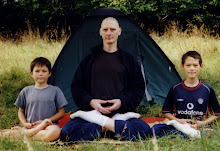

He stands in opposition to everybody and everything. Many know him as one who defies gods, but he is much more than a fighter of devas. He opposes beings in hell as well, and not always in a malevolent way; rather, by the example of his own vigorous action, he points and shouts the way out.
Reptiles and amphibians, all beings that crawl around on their bellies, propelled by cross-pattern movements of their limbs: these are both encouraged along and held back by the asura. Sheep and donkeys, creatures that walk and run on all fours: these also are originally directed forward in their development by the asura; but then the asura stands in the way of their futher progress. No further development, no fuller integration of limb movements, is possible until the asura is well and truly defeated. The asura lays the foundation for, and then -- until conquered -- gets in the way of, cross-pattern movements of the limbs, in any of the six realms.
To beings in hell, hungry ghosts, and animals, the asura points the way up to the human realm, yelling "Get a move on!" To James Cohen and the like, to the celestial devas of this world, he points the way back down, yelling: "Reality is not primarily psychological, you pretentious air heads! Pratitya-samutpada means GROUNDED arising."

The asura exhibits, very strongly and manifestly, what the asymmetrical tonic neck reflex is and what the ATNR does -- splitting everything in half, one-sidedly. When the head turns and the eyes look to the left, messages are sent, and energy is made available, for the left arm and leg (the jaw limbs) to extend, and the right arm and leg to flex.

I cannot claim the credit for identifying the connection between the asura and the asymmetrical tonic neck reflex. The credit for that goes to Tadashi Fukuda.
In a 1965 paper for the Psychological Review, the Alexander teacher Frank Pierce Jones cited Fukuda's paper in a sub-section titled Head-Neck Reflexes in Man:
"In human beings, the influence of the head-neck reflexes is masked by patterns of voluntary activity. The mechanisms are clearly present, however. They have been frequently demonstrated in infants (Gesell, 1954; Peiper 1963), young children (Landau, 1923; Schaltenbrand, 1925), patients with neurological diseases (Simons, 1923: Walshe, 1923), and in normal adults (Hellebrandt, Schade, & Cairns, 1962; Tokizane, 1951; Wells, 1944). A large number of drawings and photographs to illustrate the patterns of head-neck reflexes as they manifest themselves in dancing, sport, and everyday activity were brought together by Fukuda (1957)."
(Frank Pierce Jones, "Method for Changing Stereotyped Response Patterns by the Inhibition of Certain Postural Sets"; Psychological Review Vol. 72, pp. 196-214)
I do not have a copy of Fukuda's 1957 paper, but I have an old photocopy of a later paper by Fukuda which contains the following observations:
"It is rather surprising to find that artists of ancient times perceived the presence of the tonic neck reflex by their extremely sharp observation of their subjects and expressed it in their creations. A. Guttich (1924) carefully inspected many old Greek pieces of sculpture and discovered that the role of the tonic neck reflex underlied the composition of those statues. With the use of the concrete examples he pointed out that the lower extremity, corresponding to the jaw limbs, showed extension in various standing statues expressing static postures and that the other arm, corresponding to the skull limb, tended to be flexed. As for dynamic postures, he took the discus-thrower of Myron as an example and pointed out that the arm holding the discus, which corresponds to the jaw limb, was stretched maximally."

"In seeking similar examples in works of Japanese artists of by gone eras, the author was able to find many in which the tonic neck reflex is typically expressed.
Fig. 36 shows a Buddhist Statue: in the upper extremities the extension of the jaw limb and flexion of the skull limb may be observed clearly and, accordingly, a strong sensation of tension coupled with energy may be felt. Fig. 37 shows the God of thunder drawn by the very famous old-time Japanese painter, Sotatsu Tawaraya. Here, a perfect expression of the tonic neck reflex may be seen: i.e. extension of the two jaw limbs and flection of the two skull limbs. It is worthy of note that in this picture, not only is the head turned to the left but also the eyes are deviated to the left."
("Studies in Dynamic Posture from the Viewpoint of Postural Reflexes"; T. Fukuda,1961)

No comments:
Post a Comment